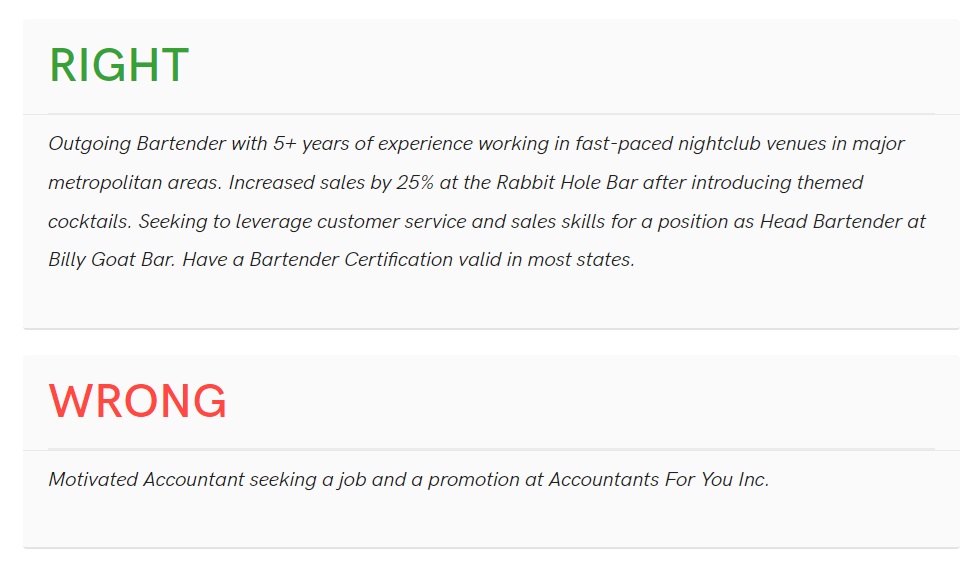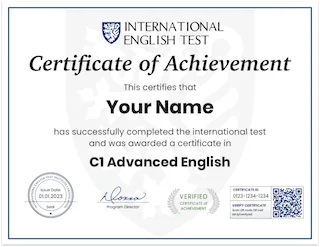Curious about the best way to structure your resume? Which resume sections to incorporate and which ones to omit? Consult our comprehensive guide for expert advice on organizing your resume effectively!
Do all resumes follow a similar structure? Whether you’re an experienced professional with accolades and skills or a novice with limited experience, the fundamental sections in both resumes remain the same. While numerous free online resume templates are available, the question arises: should your resume be as distinctive as a snowflake, or should you adhere to a conventional set of standard resume sections? The answer awaits!
That’s why this article will illustrate:
1. The essential components that constitute the foundation of all resumes.
2. The suitable “categories” to select for your resume.
3. The proper arrangement of resume sections on your resume.
What is your English level?
Find out your A1 A2 B1 B2 C1 C2 level of English with our online test and receive your English certificate.
1. The essential components that constitute the foundation of all resumes
What components are essential for a typical resume?
A regular resume should encompass five fundamental sections:
Mandatory Resume Sections
- Contact Information
- Resume Summary or Resume Objective
- Work Experience Section
- Education Section
- Skills Section
The aforementioned sections of a resume carry the most significance.
However, there are numerous additional distinctive resume sections that can enhance your resume.
That’s because you can split resume sections into two categories:
- Basic
- Optional
Now that you’re acquainted with the five fundamental sections, what supplementary details can you incorporate into your resume?
Optional Resume Sections
- Awards and Honors
- Volunteer Work
- Certifications and Licenses
- Projects
- Hobbies and interests
- Qualifications
- Extracurricular Activities
- Accomplishments
- Associations
- Publications
- Languages
- Training
- Conferences
You also have the option to categorize your skills section on your resume into various segments:
- Personal Skills
- Management Skills
- Technical Skills
- Computer Skills
- Additional Skills

What other sections should you incorporate into your resume?
- Resume Project Section
- Resume Language Section
- Resume Awards Section
Avoid including resume categories unless you can provide a few items in each section.
Give precedence to the unique resume sections you decide to incorporate. Begin by selecting categories that are both highly pertinent and impressive.
For instance, a Project Manager might have extensive volunteer experience, but including a resume volunteer section may not be as pertinent as highlighting projects, languages, and awards.
If space permits, you can add additional personalized resume sections. However, bear in mind that the optimal resume length is generally one page, with a maximum limit of two pages.
Professional Tip: There are certain resume sections that are now deemed unnecessary. An example of such a section is the resume references section. Hiring managers are aware that they can request references from you directly, eliminating the need to include this information on your resume.
Are you C1 Advanced English?
Get your C1 Advanced English certificate now!
✓ Add your certificate to your resume
⭐ ⭐ ⭐ ⭐ ⭐
2. The suitable “categories” to select for your resume
Determining which resume sections to include is the straightforward aspect.
The challenging part involves assembling the various components of a resume in a way that optimally showcases your qualifications.
Hiring managers are accustomed to a specific sequence of resume sections. Simultaneously, the most effective arrangement of elements on your resume is one that emphasizes your most compelling attributes.
Therefore, achieving a balance is crucial. Adhere to a conventional resume format but organize the sections strategically to accentuate your strengths.
Sequence of Resume Sections for a Typical Resume
- Contact Information
- Resume Summary
- Experience
- Certifications
- Education
- Skills
- Additional Sections
For typical job applicants with a work history, it’s advisable to begin with your experience.
If your profession involves a certification, it’s recommended to incorporate it into your job title, the resume certification section, and possibly in your education section too.
Sequence of Resume Sections for University Students
- Contact Information
- Resume Objective
- Education
- Experience/Internships
- Extra Curricular Activities (Leadership Section)
- Skills
- Hobbies and Interests
For a student or a candidate at the entry level, your education stands as your most compelling asset. If you’ve participated in internships or gained any work experience, that should be presented next.
Incorporating relevant extracurricular activities on your resume is also advisable, particularly if you held a leadership role. Leadership is identified as one of the primary skills sought by hiring managers in recent graduates, as indicated in our HR statistics report.
Why include hobbies and interests on your resume?
Incorporating a resume interests section can indicate to hiring managers that you align well with the company’s culture. Investigate the organization’s culture and select a few of your interests that mirror that cultural fit.
Sequence of Resume Sections for an Experienced Professional Resume
- Contact Information
- Resume Summary
- Experience and Accomplishments
- Associations and Certifications (Optional)
- Education
- Skills
- Additional Sections
For a seasoned professional at the senior level, the key is to elevate the standard sequence with a touch of flair.
With ample experience comes a wealth of achievements, so ensure to incorporate them into your experience section. Prominent professionals often engage in activities like speaking at conferences, publishing, or joining associations.
Remember to include these notable aspects in their respective resume sections.
Sequence of Resume Sections for a Resume Aimed at Career Change
- Contact Information
- Resume Objective
- Relevant Experience
- Additional Experience (Optional)
- Education
- Skills
- Additional Sections
When transitioning careers, it’s possible that not all your previous roles align with your new path. However, if you’ve held noteworthy positions, it’s still essential to include them in your resume.
Consider bifurcating your resume experience section if needed. For instance, transitioning from an Accountant to a Chef presents a scenario where your past roles may not directly relate. In such cases, eliminate the additional experience section and prioritize your relevant training, such as completing coursework at Le Cordon Bleu, by placing it closer to the top of your resume.
Pro Tip: The key to organizing your resume sections is understanding your strengths. Hiring managers typically focus on the top third of your resume first. Ensure that your most pertinent and impressive qualifications are prominently placed at the top.

3. The proper arrangement of resume sections on your resume
Alright, you’ve identified the strategic resume sections to include, and you’ve determined the optimal order for your resume.
However, you might be pondering, “Is it really essential to have a skills section on a resume? And what exactly should go into the experience section?”
These are valid questions, and let’s address them now.
Contact Information Resume Section
Each resume should have a “Contact Information” segment.
Include your name, phone number, and email address in this section. Optionally, you can also add social media handles (such as LinkedIn), licenses, and links to your website or blog. It is no longer essential to include your physical address on your resume.
Avoid incorporating details in your “About Me” resume section that could lead to discrimination.
Additionally, it is not customary to include a photograph on an American resume.
pro tip: You can subtly include degree or license information in your email address. For instance, [email protected]. This is a clever way to integrate vital information into your contact section without utilizing extra space.
What is your English level?
Find out your A1 A2 B1 B2 C1 C2 level of English with our online test and receive your English certificate.
Resume Summary and Resume Objective
Whether you’re a recent graduate or a seasoned professional, kick off your resume with impact.
Incorporate a resume summary, objective, or profile at the outset of your resume.
Wondering which of these three resume sections suits you best?
The resume summary is ideal for professionals with notable achievements and skills. This section communicates to a hiring manager that you are a seasoned professional equipped with the necessary skills for the job. Include a concise summary to spotlight your most pertinent and impressive skills.

For those in different categories such as entry-level candidates, students, or career changers, the objective is the recommended choice. It functions as a resume introduction, providing a hiring manager with information about your current status and your aspirations.
In the case of IT professionals, incorporating a profile section is advisable. This section consists of a bullet point list highlighting the essential skills and knowledge required for the job. The list serves as a quick indicator to the hiring manager that you possess all the qualifications they are seeking.
Pro Tip: Customizing all your resume sections to align with the job requirements is crucial. However, if you’re focusing on just one section, make it your resume summary. Incorporate key phrases and skills mentioned in the job offer. This approach ensures that the hiring manager quickly identifies the qualifications they are seeking.
Resume Experience Section
One could argue that the experience section holds significant importance in a resume.
To ensure easy accessibility for both human readers and automated systems, it is advisable to stick with the standard heading “Experience” rather than opting for an alternative title.
Many companies employ Applicant Tracking Systems (ATS) software for resume scanning. Simplifying your resume section titles enhances the software’s ability to interpret your resume.
Within the experience section, include relevant positions held, presented in reverse-chronological order, starting with the most recent role. Specify your title, dates of employment, company name, and location.
Use up to six bullet points to outline both your responsibilities and achievements. Rather than listing every mundane duty, focus on responsibilities that mirror the skills outlined in the job offer.
Incorporate quantifiable achievements to demonstrate that your execution of responsibilities yields tangible results.

Resume Education Section
Similar to your experience section, label your education section as “Education.”
Include all your educational qualifications, beginning with your highest degree.
Present your degrees in reverse-chronological order, listing the most recent ones first. If you have completed college, there is no need to include information about your high school.
What to include:
- Type of Degree
- Your Major/Minor
- Name of School
- School’s Location
- Year Graduated (or Anticipated Graduation Date)
- Relevant Coursework (optional)
Ensure that your highest degree takes precedence.
Pro Tip: You have the option to include unfinished degrees on your resume. As you’ve invested in those credits, they rightfully belong to you. The formatting may differ slightly. State: “Completed 45 credits toward a degree in Biology,” placing this information under the school’s name and the dates of attendance.
What is your English level?
Find out your A1 A2 B1 B2 C1 C2 level of English with our online test and receive your English certificate.
Resume Certifications Section
If you hold professional licenses or certifications, consider incorporating a resume certification section.
This is a section where you have the flexibility to combine elements. You might choose to simply title the section “Certifications.” Alternatively, if you also have licenses, you can use the title “Licenses and Certifications.”
What to include:
- Name of Certification
- Name of Certifying Body or Agency
- Date Certified
- Location (If Applicable)
Ensure to spell out acronyms at least once, particularly if the job offer primarily uses acronyms for certifications. Avoid listing every certification you possess on your resume.
For instance, if you’re a Project Manager, your PMP certification holds significance and relevance, while your CPR certification may not.
Pro Tip: You can also incorporate your license or certifications in your contact information section. You may even place it alongside your name. For instance, Douglas Fisher, PMP.

Resume Skills Section
Is it essential to have a skills section on your resume?
Certainly, including a skills section is crucial in your resume.
One of the primary aspects that a hiring manager looks for when scanning your resume is whether your skills align with those specified in the job offer.
Hence, furnishing a list that corresponds to the skills mentioned in the job ad enhances your chances of securing the position. Determine the relevant skills by thoroughly reading the job offer and incorporating those that align with your capabilities.
Provide additional details to showcase your proficiency, making your skills more tangible for the hiring manager. Quantifying your skills enhances your credibility.
Pro Tip: Don’t confine your skills to just the skills section. Distribute them throughout your resume, incorporating them into your resume summary and experience section. Infuse your skills seamlessly into your resume, persuading the hiring manager that you are the ideal candidate.

Hobbies and Interests Resume Section
The inclusion of hobbies and interests is one of the more debated sections on a resume, yet it can have a significant impact.
Incorporating a resume interests section can signal to a hiring manager that you’ll blend well with the company’s culture.
To determine which interests to include, conduct research on the company. For instance, if the company values social responsibility, include volunteer work. If they engage in marathons, add a physical activity. If the role involves more sedentary tasks, include a quiet activity to demonstrate your capacity for focused work.
Align your interests with the company culture. It’s crucial to avoid adding unconventional hobbies, even if attempting humor, as it may not be well-received. Additionally, steer clear of topics like sex, drugs, religion, and alcohol to foster relatability rather than creating potential controversy.
Pro Tip: Provide more than just one-word hobbies. Instead of simply stating “Dancing, Traveling, Eating,” offer additional details. For instance, specify that you enjoy dancing Salsa and Tango at a local dance school. This provides the hiring manager with a more comprehensive understanding of your personality.

What is your English level?
Find out your A1 A2 B1 B2 C1 C2 level of English with our online test and receive your English certificate.

I am Nilay, an experienced English Language Assessment Director at the International English Test, where I have been working full-time since February 2020. I specialize in helping people worldwide validate their English proficiency through comprehensive assessments and certifications.
Before joining the International English Test, I worked as a self-employed English Language Assessment Consultant from January 2015 to December 2019. During this time, I assisted companies and individuals in improving their language skills, helping them achieve their academic and professional goals.
I hold a degree in Engineering and have also studied at Shafston International College in Australia. My educational background has equipped me with the tools to make a meaningful impact in the field of English language learning. Additionally, I enjoy sharing my expertise through articles that explore effective teaching methods and language assessment strategies, contributing to the International English Test and the broader assessment community.





